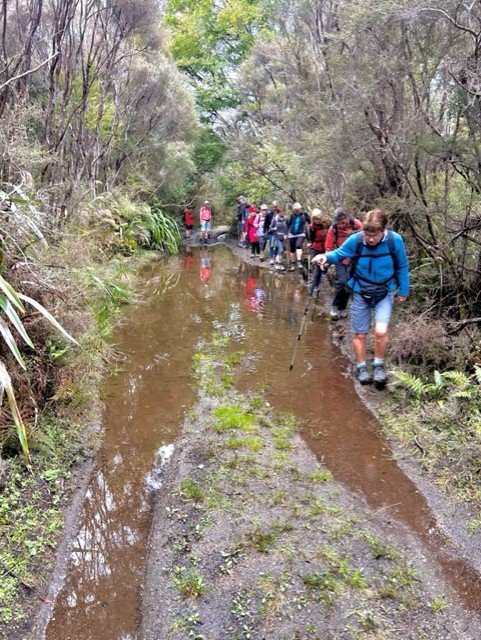Nature takes back the land
The Kiwi version of the Pillars of Hercules.
Big trucks, fast cars, and a fine collection of motor bikes sped past as we gingerly crossed State Highway 1 and ducked into the relative safety of bush on the edge of the Desert Road.
Mānuka, kānuka, scrambling clubmoss, tapuwae kotuku or umbrella fern along with a number of scratchy bushes crowded in over the narrow trail which was once a dray route.
In the early 1900’s farmers attempted to tame the area we were exploring for sheep farming.
After WWI the reduced value of wool and the costs of transporting produce by dray and then steamer from Tokaanu or overland to the Hawkes Bay became prohibitive and farming at Mangamate ceased.
While nature has reclaimed and ‘untamed’ the land many relics remain and are gently draped with moss and lichen.
Our first find was a bucket shaped lump of concrete, the outer wooden or metal mold long since rotted away.
Not far away was an old water tank, covered in resplendent green moss. Its bung was nearby.
The sheep dip was partially full of water, and we could just see the outline of the pad the sheep would have stood on to dry.
Dipping was a method of plunging sheep into a diluted chemical mixture, which in those days was often arsenic, to protect them from ticks, lice and sheep scab.
We now know these chemicals can remain in the soil and contaminate the groundwater.
We fanned out and found pieces of iron, tōtara posts and post holes.
What a battle these farmers must have had trying to transform the land and the tussock into productive pasture.
The pumice, ash and scoria soil are poor retainers of moisture and strong winds funnelling down from the mountains are also drying.
Frost and snow would have made life hard.
We then headed up the track to the site of the staff quarters. Here pieces of an old oven had been gathered together, and we also found the old doorstep and possibly a remnant of chimney.
There was a considerable amount of windfall, probably from Cyclone Gabrielle in this area.
Along with beech trees we also saw tanekaha, straight and graceful trees. Tanekaha have real, very small leaves and more prominent leaf lookalikes or branchlets that perform most of their photosynthesis.
Their wood is one of the most elastic timbers in the world and a walker recalled how it could be used to make fishing rods.
The piercing screech of the kokoeā or shining cuckoo reminded us that it was time for these birds to return after wintering over in the tropical Pacific.
We left the area and drove to the entrance of the Pillars of Hercules Track. The signage optimistically said 30 minutes, and it wasn’t until sometime later we realised this timing was for speedy mountain bikers!
The track was road-like, but through bush. It also had some extremely large puddles which had us skirting along the elevated verge trying to keep our boots dry.
It was all worth it when we reached the suspension bridge. This bridge was built in 2006 and is 40 metres above the Tongariro River.
Water gushes through a narrow chasm carved through an ancient lava flow made of andesite and ignimbrite.
The pillars are not visible from the bridge but by following the track and then an unmarked trail we could see the dark gap in the rock face and deep blue water flooding through the ravine.
We enjoyed the view and the beauty of the beech trees surrounding us before walking back up the track.
A great day with lots of knowledge shared.
For more information about our group search Taupo Monday Walkers on Facebook, or email walkersmondaytaupo@gmail.com


